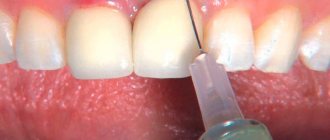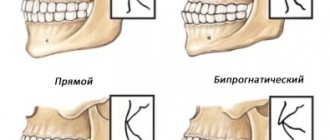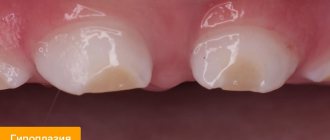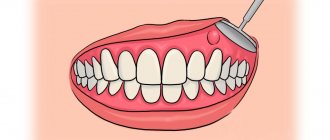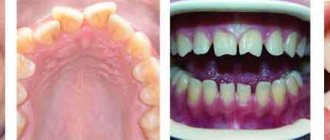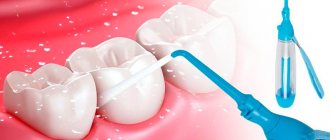Diastema is an empty space between teeth, ranging in size from one to five to six millimeters. A characteristic gap forms between the front incisors. Moreover, in some its appearance is due to heredity, in others - anomalies in the structure of the dental system.
The reason may be incorrect position of the teeth, pathologies in the structure of the frenulum, partial edentia, for example, the absence of lateral incisors or microdentia - the small size of dental crowns. Sometimes diastema is provoked by bad habits - biting pencils, pens and nails, as well as sucking a pacifier for a long time in childhood.
What is the difference between a diastema and a trema?
Interdental gaps can appear not only on the front teeth, but also anywhere in the upper or lower jaw. In this case, empty spaces are called trems. Just like diastemas, they can arise due to various factors. Among the most common are malocclusion, premature tooth loss, and heredity.
The localization of trema depends on the cause that provoked it. Thus, trema in the lower jaw appear due to the mesial relationship of the dentition, and the spaces between the canines and lateral incisors are due to partial edentia.
Anomalies in the shape and size of teeth - symptoms and treatment
Anomalies in the shape and size of teeth are variations in the development of teeth and the dental system that deviate from the norm.
Malformations of the dental system are divided into major (congenital) and minor. Congenital anomalies include facial clefts, such as cleft lip, cleft palate, etc.; to small ones - anomalies in the eruption, number, shape, size and structure of teeth. Unlike congenital malformations, minor anomalies are not accompanied by significant impairments and do not threaten the patient’s life, but they significantly affect the aesthetics of the tooth and treatment tactics, and can also lead to caries, malocclusion and other complications [1].
This article describes frequently occurring minor anomalies in the shape and size of teeth: macro- and microdentia, fusion of teeth, etc. Absolute and relative indicators of their frequency and prevalence are shown in the table below [11].
| Types of anomalies | Anomaly subtypes | Frequency of anomalies in the population (%) | Prevalence of anomalies (%) |
| Size anomalies | Macrodentia | 0,42 | 0,16 |
| Microdentia | 7,87 | 3,08 | |
| Shape anomalies | Fusion and fusion of teeth | 0,21 | 0,08 |
| Taurodontism | 11,27 | 4,41 |
Subtypes of anomalies and reasons for their development
All anomalies in the shape and development of teeth can be formed under the influence of negative factors that disrupt the development of fetal tissues and organs during pregnancy. These include:
- medications;
- nutritional supplements;
- viruses;
- industrial poisons;
- alcohol;
- tobacco smoke, etc.
Macrodentia is characterized by an increase in the size of the teeth - a large crown and a tapering root. It can affect both all and individual teeth [5]. The prevalence of macrodentia in permanent teeth is 0.03-1.9%. This pathology occurs more often in men. The large size of the crown causes problems with teething and leads to deformation of the dentition [9][10].
Microdentia is characterized by the reduction of one or all teeth [6]. According to epidemiological studies, the prevalence of the anomaly ranges from 1.5% to 2%, and is more common in women than in men [19]. Teeth with this pathology usually have a cone shape.
Macro- and microdentia can be hereditary. Since the formation of follicles (buds) of permanent teeth occurs at different times, starting from the 5th month of intrauterine development and up to 3 years, the number of abnormal teeth will depend on the impact of negative factors during this period.
Taurodontism (bull tooth) refers to abnormalities in tooth shape. It manifests itself in the form of an enlarged pulp chamber - the “core” of the tooth, consisting of connective tissue, nerves, blood and lymph vessels. The base of the pulp moves closer to the apex of the tooth, and there is no narrowing at the level of the cemento-enamel junction [12].
Taurodontism can occur at any age; it is most often found in patients 13-19 years old [11]. As a rule, the anomaly does not appear before this age, since the roots of permanent chewing teeth form before the age of 13.
Dental evagination (protrusion) affects the crown of the tooth. The anomaly occurs during the period of formation and formation of tooth buds. It appears in the form of an additional tubercle that protrudes from the crown of the tooth. This tubercle consists of enamel and dentin. Its size, structure and location vary widely. It can be horny, conical or pyramidal in shape. Otherwise, such an anomaly is called a tuberculate protrusion, a claw-shaped tubercle, a Leong premolar, and an occlusal enamel pearl.
The reasons for the development of evagination are not fully understood. The influence of X-linked and autosomal dominant inheritance is assumed [2]. With X-linked inheritance, the anomaly appears only in men, and women are only carriers of the mutant gene. With autosomal dominant inheritance, boys and girls with dental evagination are born equally often, and at least one of the child’s parents also has this anomaly.
Dental invagination causes the enamel to retreat into the dental crown. Otherwise, such an anomaly is called a “tooth in a tooth.” Intussusception occurs before calcification of dental tissues during fetal development [13]. It can affect any tooth, but most often occurs on the upper lateral incisors (front teeth).
What types of diastema exist and why do they occur?
Diastemas, as well as tremata, come in different types. Experts divide them by etiology, location, and type of displacement. Doctors also distinguish between false and true diastemas separately. The latter are always a consequence of pathology, while false ones are found only in children and disappear as the teeth grow.
Symmetrical and asymmetrical diastema
Most often, the diastema is symmetrical, that is, the incisors are equidistant from the frenulum. An asymmetrical arrangement is much less common, and with it, only one incisor is displaced, the second is in the correct position.
Lateral deviation of crowns
With lateral deviation of the crowns, the roots are located correctly, the discrepancy begins only on the visible part of the teeth. Most often, this pathology is a consequence of supernumerary teeth. Also, a gap may appear due to bad habits.
Body lateral displacement
The peculiarity of this type of displacement is the complete deviation of the teeth along with the roots. It is provoked by congenital adentia, the lower attachment of the frenulum, and compaction of the middle suture on the bone tissue. In the latter case, the teeth cannot overcome the obstacle and take the correct position.
Medial inclination of central incisors
This type of diastema is the most difficult, since it simultaneously causes deviation of the teeth from the center and their rotation along the axis. The cause is almost always supernumerary teeth located between the first incisors or odontoma, a benign tumor growing in the jaw bone.
Types of diastemas
Dentists distinguish several types of diastemas:
- False. Usually a gap appears between the teeth of a child during the appearance of primary incisors. There is no need to see a dentist. The gap will disappear on its own after the permanent incisors cut through.
- True. In the absence of other defects, diastema appears in adolescents, when primary dental units are replaced by permanent ones.
- Physiological trema. Appears during the growth of the jaw bones.
- Pathological trema. Occurs in patients with permanent teeth after gum disease or bone atrophy.
People who develop gaps in their teeth often experience communication problems that affect their careers and lives.
To understand how to close the gap between the front teeth, you need to understand the classification of diastemas:
- Parallel. The gap between dental units is no more than 4 mm;
- Triangular. The dimensions are larger than those of the parallel one, it has the shape of a triangle. In some cases, the apex is located near the frenulum, and in others, near the border of the crowns. The reason is the formation of an extra incisor.
Why is an unclosed diastema dangerous?
The large distance between the teeth cannot be ignored. You need to visit an orthodontist, who will tell you what caused the pathology and whether it needs correction. At ORTHODONT CENTER clinics, the first consultation is free. If the doctor suspects serious changes in the structure of the jaws, he will conduct a detailed examination using X-ray equipment or a CT scanner.
If the situation is unfavorable, the specialist will offer various types of correction that can remove the cleft and at the same time eliminate the problems associated with it. Untreated diastema can lead to gum disease, the formation of “pockets” in the periosteum, and premature tooth loss. Due to the diastema, incorrect pronunciation of hissing and whistling sounds may occur.
Folk signs in Eastern countries
Residents of the East recognize a gap between teeth as a bad sign; for a long time, gap-toothed people have been treated here with caution and caution. According to Eastern superstition, sparse teeth are considered a sign of dishonesty.
According to some teachings, the entire human jaw was divided into areas, each of which was responsible for certain qualities, abilities and personality traits of a person. Thus, the 8 anterior teeth of the upper jaw are responsible for the ability to analyze. And the bottom eight is responsible for spiritual qualities, with each tooth representing one specific one. Accordingly, if a tooth is missing or affected by disease, the corresponding quality of soul is considered underdeveloped or does not exist at all.
Ways to eliminate gaps between teeth
Surgical plastic surgery
Surgical methods for correcting diastema can be used either alone or in combination with other measures. In childhood, sometimes it is enough to reduce the tension of the frenulum so that the teeth take the correct anatomical position. If the cause of the diastema is the supernumerary of teeth, their removal alone is not enough - alignment is required with braces or orthodontic caps.
Surgical intervention is also required for various types of disposition, when teeth erupt outside the dentition. In this case, the incorrectly located tooth is removed and orthodontic movement of the adjacent teeth is carried out.
Implantation
Braces
Implantation
Unfortunately, with diastema, teeth cannot always be straightened. Particular difficulties arise with medial inclination of the incisors. If the rotation of the tooth is too great, the specialist may decide to remove it and replace it with an implant. Since the procedures are carried out over a short period of time, the process of bone loss does not have time to begin, and implantation does not cause difficulties.
Braces
Braces are the most popular way to correct orthodontic problems, including those that cause the formation of diastema. Their main advantages are high efficiency and the ability to be used in patients of all ages. Braces are installed for both children and adults. But due to the nature of the growth of the dental system, which continues until the age of 18-20, correction requires less time in younger patients. Treatment after this age, depending on the severity of the pathology, can last two to three years.
Wearing braces requires a conscious approach - you should not skip scheduled visits to the orthodontist, nor should you remove the installation yourself. After completion of the main treatment, a retention period begins, during which the doctor prescribes the use of mouth guards or plates. If they are neglected, the teeth may return to their original position and the correction will have to be done again.
Crowns and veneers
Crowns and veneers can be used as primary and additional correction methods. With lateral deviation, when the roots of the teeth are located evenly and do not need to be turned, the gap is simply closed with crowns. Veneers, in this case, are installed on adjacent teeth to hide the increased transverse size of the central incisors.
The doctor may also recommend using veneers on the front teeth if, after eliminating the diastema, it turns out that the crowns are not in the best condition. It is important to understand that if the cleft is a consequence of malocclusion, overcrowding, disposition or other dental pathology, it makes no sense to install veneers until the problem is eliminated.
Aligners (aligners)
Orthodontic plate
Records
Plates are mainly used to treat diastema in children when the jaws have not yet formed and less effort is required to correct the irregularities. Plates are removable structures that can be installed on one or two rows of teeth at once. They consist of a palatal part and arches, which are located in such a way as to exert pressure on the teeth and, thereby, help them move into the desired position.
The plates are removable and non-removable. The latter, like braces, are installed for a long time, and, at certain intervals, the doctor adjusts their position and changes the tension force. When treating with removable structures, several devices may be needed per course of treatment.
Plates are the best solution when it comes to correcting diastema in children. They do not cause severe discomfort even at the initial stage of treatment, they can be removed while eating, plus, the devices themselves are inexpensive.
The disadvantage of the plates is the impossibility of their use as the main method of treatment in adult patients and in complex clinical cases.
Mouthguards
Mouth guards are removable structures that are placed over the teeth in the form of a cover. Despite the softness of the material, it puts enough pressure on the teeth to return them to their correct position. Several trays are made for the entire treatment period, and the size of each subsequent design is reduced. Thanks to this, the movement takes place without pain and discomfort. Another important advantage of mouth guards is transparency. When worn, they are practically invisible to others. Among the disadvantages are the inability to use for complex cases and the rather high cost.
Cosmetic correction and artistic restoration
These methods are very similar - the gap between the teeth is closed using filling materials. If phosphate cements are used during the work, this is considered a cosmetic correction. The use of modern photopolymer materials allows us to talk about artistic restoration. The difference between the methods is in the external result and durability. Artistic restoration allows you to achieve better aesthetics, and thanks to the strength of filling materials, the result lasts several times longer.
However, these two methods are purely cosmetic and do not solve the problem itself. They are only suitable in cases of lateral deviation of the crowns. At the same time, no matter what materials are used, the patient will have to forget about solid foods such as seeds, crackers or nuts.
Gap between teeth in a child
When examining children, a gap between the teeth is found in, on average, 10% of 2000 people.
When moving to a permanent dentition, this figure decreases to 0.9%. Despite the fact that these data are conditional, they illustrate the surmountability of childhood diastema.
If a child between the ages of 12 and 18 years has a diastema, it can be corrected using the same methods used for adults. But to determine the treatment method, it is necessary to clarify whether both incisors have a distal deviation or only one of them. This is important for choosing a treatment method.
Prevention of recurrence of diastema
Relapses in orthodontic treatment, unfortunately, occur frequently. This is especially frustrating considering how much time and money is involved in fixing the problem. In the case of diastema, its appearance can be caused by various reasons. The most common are incorrectly selected treatment and neglect of the orthodontist’s recommendations during the retention period.
Sometimes patients refuse the necessary surgical treatment or wearing braces, and insist on “simple” correction methods, for example, installing crowns or masking the gap with composite materials. But since the problem remains unresolved, the diastema will return.
Likewise, she will not keep you waiting if, after treatment, the patient decides to ignore the orthodontist’s recommendations and does not wear retention devices.
Is diastema dangerous?
Parents of young patients who have a gap between their front teeth are concerned about the significance of this phenomenon for the health and condition of the oral cavity.
And indeed, there are negative consequences. Noticeable gap in the dentition:
- worsens diction, which in some cases becomes an obstacle to professional activity;
- creates conditions for spitting out saliva during conversation;
- promotes the deposition of tartar along the edges of the defect and the occurrence of caries;
- causes psychological discomfort due to violation of aesthetics.
Is it possible to fix a hole between teeth at home?
It is impossible to remove diastema at home. To carry out effective correction, specialists use a whole range of diagnostic measures, as well as devices that are manufactured specifically for the patient. It is naive to believe that the problem can be eliminated simply by tying the two front teeth with floss. Moreover, such manipulations are dangerous, as they can damage the gums or the teeth themselves.
Sometimes you can hear stories about how a child's teeth were bandaged and the cleft disappeared. But, in this case, we are talking about a false diastema, which goes away on its own without any intervention.
How do different peoples feel about the presence of gaps between teeth?
Residents of Yorkshire and Scotland believe that God favors gap-toothed people, especially those with a sovereign through their crack. In some British areas there is a belief that a baby born with a gap between his teeth will be extremely lucky and fabulously rich. Most Britons believe that gap-toothed people are generous and intelligent. However, among the Scots of the northwestern regions, a gap between the front teeth is an indicator of carelessness and excessive enthusiasm for the opposite sex.
Russians attribute generosity, intelligence and a penchant for travel to a person with a gap between his teeth. There is a sign that petty natures with a quarrelsome character have small and frequent teeth.
In China, the appearance of teeth is of great importance. In the Celestial Empire, it has always been accepted that people with dense, snow-white teeth are the happiest. The number of teeth also matters - the more there are, the richer and luckier the person in love. The Chinese consider a gap between the front teeth to be a sign of incontinence and a tendency to intrigue. Children with a gap are predicted to have a poor and unhappy life.
Scientists have found that testosterone levels affect men's generosity
By entering a lucid dream, you can control your future: how to do it
With copper-brown veining and other fashionable shades of chestnut coloring
How to prevent diastema in a child
If diastema is a common occurrence among relatives, the parents of a small child should inform the dentist about this when the child is 2-3 years old. The specialist will observe the dynamics and, if necessary, offer age-appropriate types of correction.
Among the general recommendations on how to prevent gaps between teeth in children, the main one is to ensure that the child does not develop bad habits, such as biting nails, pencils and pens, and sucking fingers.
Shcherbinka is a sign of talent
Modern physiognomists have noticed that a gap between teeth is an indicator of great creative potential. People with gaps are energetic, ambitious and persistent, so they achieve their intended heights. They often shock society with their extravagant behavior. Those with gap hair are people who love to talk. They have good diplomatic skills.
The list of famous people with gaps includes the famous singer Alla Pugacheva, Madonna and Vanessa Paradis, and the popular model Lara Stone.
Shcherbinka is a natural gift that endows its owner with truly outstanding talents!
Is it possible to eliminate it at home?
There are situations when there is simply no money for treatment, but you really want to get rid of the defect. Unfortunately, the incisors cannot be adjusted at home without the intervention of a doctor; only a professional can help you with this using certain equipment and materials.
The only acceptable option for how to close the gap between the lower teeth is to make a homemade analogue of the braces system. It is necessary to tighten the twisted units tightly every time before going to bed for a long time. This is a relatively effective method, so there is no guarantee that it will help or not cause harm. The best way out in any such situation is to contact a qualified orthodontist.
Is it possible to remove the gap between the front teeth: how are adults and children treated?
Modern dentistry has a whole arsenal of methods with which it is possible to cope with the problem, including in just one visit to the doctor. Thanks to comprehensive high-quality diagnostics, it is possible to identify the exact causes of the defect, as well as develop effective therapeutic regimens.
Some procedures are relevant only for children. Others are suitable for patients of different ages. All manipulations must be performed by professional orthopedists, orthodontists and other specialists. This means that therapy at home will not give any results.
